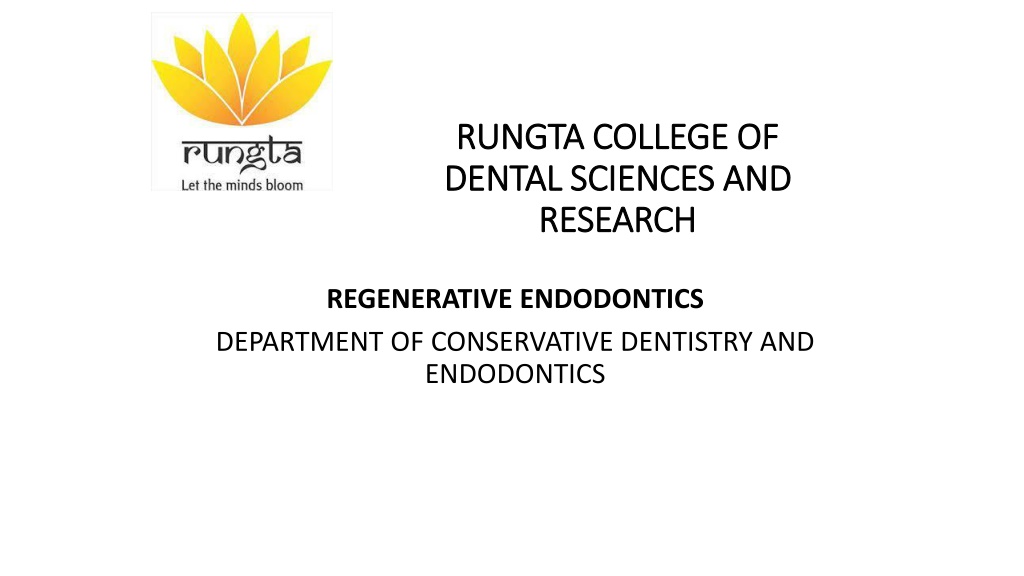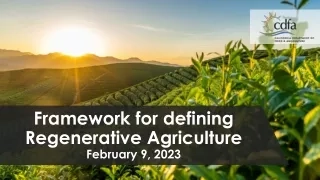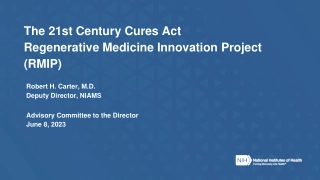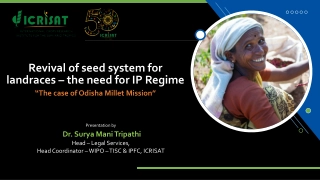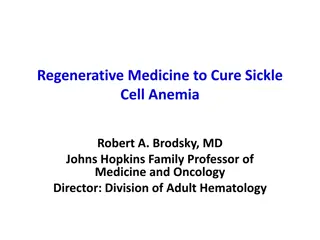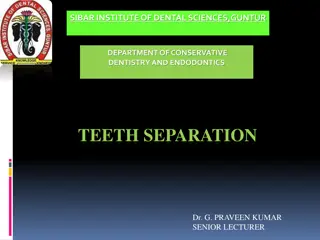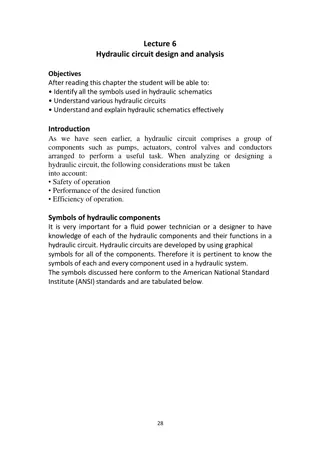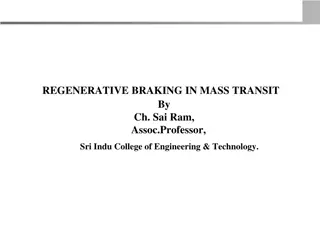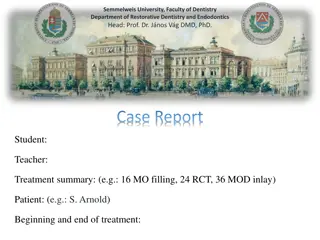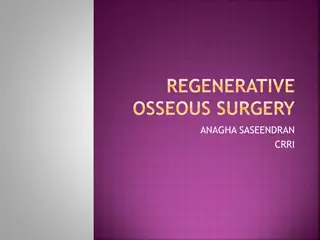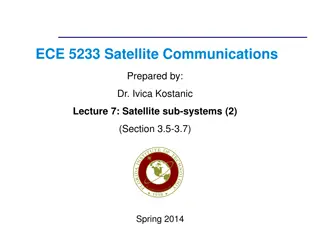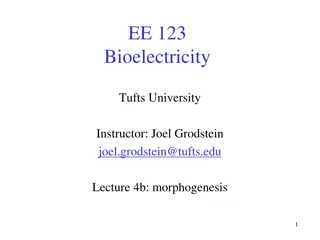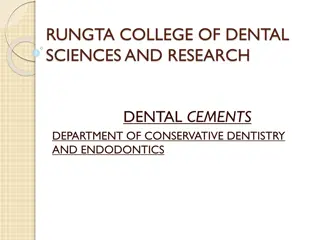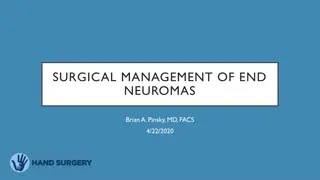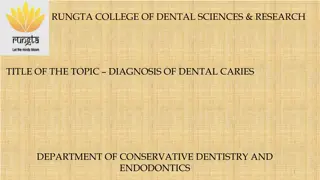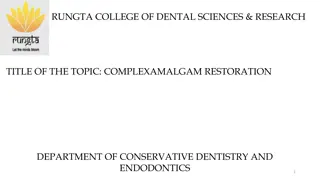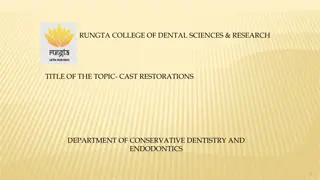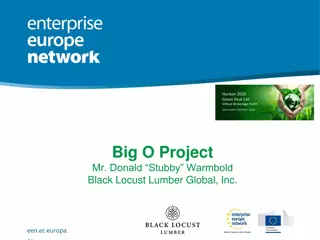Regenerative Endodontics Overview
This presentation covers various aspects of regenerative endodontics, including definitions, history, current scenario, goals and objectives, stem cell classification, fundamental properties of stem cells, and specifically focusing on dental pulp stem cells (DPSCs). Learn about the clinical studies and procedures related to regenerative endodontics, the trilogy of regeneration, and different stem cell sources in dentistry.
Download Presentation

Please find below an Image/Link to download the presentation.
The content on the website is provided AS IS for your information and personal use only. It may not be sold, licensed, or shared on other websites without obtaining consent from the author.If you encounter any issues during the download, it is possible that the publisher has removed the file from their server.
You are allowed to download the files provided on this website for personal or commercial use, subject to the condition that they are used lawfully. All files are the property of their respective owners.
The content on the website is provided AS IS for your information and personal use only. It may not be sold, licensed, or shared on other websites without obtaining consent from the author.
E N D
Presentation Transcript
RUNGTA COLLEGE OF RUNGTA COLLEGE OF DENTAL SCIENCES AND DENTAL SCIENCES AND RESEARCH RESEARCH REGENERATIVE ENDODONTICS DEPARTMENT OF CONSERVATIVE DENTISTRY AND ENDODONTICS
Specific learning Objectives At the end of this presentation the learner is expected to know ; Core areas* Domain ** Category # Introduction Cognitive Nice to know Definitions Cognitive Must know Indications Cognitive Must know Single vs Multiple visit endodontics Cognitive Must know
CONTENT INTRODUCTION HISTORY DEFINITIONS PRESENT SCENARIO OF REGENERATIVE ENDODONTICS GOALS & OBJECTIVES TRILOGY OF REGENERATION Stem Cells Growth Factors/Morphogens Scaffolds Delivery System CLINICAL STUDIES ON REGENERATIVE ENDODONTICS Clinical Procedures Related to Regenerative Endodontics Overview of Clinical Revascularization Cases AAE Revascularization Protocol Newer Approaches for regenerative endodontics Clinical Measures of Treatment Outcome CONCLUSION REFERENCES
CLASSIFICATION OF DENTAL STEM CELLS Dental stem cell Epithelial stem cell Mesenchymal stem cell Stem Cells From Human Exfoliated Deciduous Teeth (SHED) Periosteal Derived Stem Cells (PSCs) Gingival- derived Mesenchym al Stem Cells (GMSCs) Oral Stem Cells Of The Apical Papilla (SCAP) Salivary Gland Stem Cells (SGSCs), Tooth Germ Progenitor Cells (TGPCs) Bone Marrow Stem Cells (BMSCs) Inflammatory Periapical Progenitor Cells (IPAPCs) Dental Follicle Stem Cells (DFSCs) Epithelial Stem Cells (OESCs), Dental Pulp Stem Cells (DPSCs) Egusa H et al: Stem cells in dentistry part I: stem cell sources, J Prosthodont Res
FUNDAMENTAL PROPERTIES OF STEM CELLS Undifferentiated cells Have not developed into a specialized cell type Long- term self- renewal The ability to go through numerous cycles of cell division while maintaining the undifferentiated state Production of progenitor cells Capacity to differentiate into specialized cell types. ( eg. Odontoblast, osteoblast, adipocyte, fibroblast)
DENTAL PULP STEM CELLS (DPSCS) DENTAL PULP STEM CELLS (DPSCS) DPSCs - isolated in 2000 by Gronthos et al. dentin-pulp-like complex composed of a mineralized matrix of tubules lined with odontoblasts, and fibrous tissue containing blood vessels in an arrangement similar to the dentin-pulp complex
STEM CELLS FROM THE HUMAN EXFOLIATED STEM CELLS FROM THE HUMAN EXFOLIATED DECIDUOUS DECIDUOUS TEETH (SHED) TEETH (SHED)
SHED - isolated in 2003 by MIURA et al Main task formation of mineralized tissue enhance oro-facial bone regeneration. Higher proliferation rate than stem cells from permanent teeth Generates dentin-pulp like tissue with distinct odontoblast like cells.
ADVANTAGES: Can be retrieved from a tissue that is disposable and readily accessible SHED banking is more economical when compared to cord blood and may be complementary to cord cell banking Ideally suited for young patients at the mixed dentition stage who have suffered pulp necrosis in immature permanent teeth as a consequence of trauma. SHED may also be useful for close relatives of the donor such as grandparents, parents and siblings
STEM CELLS OF APICAL PAPILLA (SCAP) STEM CELLS OF APICAL PAPILLA (SCAP) SCAP isolated in 2008 by SONOYAMA et al. Located at the apex of developing human permanent teeth and termed this tissue apical papilla. Essential for root development Loosely attached to the apex of the developing root and can be easily detached with a pair of tweezers. SCAP are capable of forming odontoblast-like cells, producing dentin in vivo.
Collateral circulation due to its proximity to the periapical tissue vasculature Survive during the process of pulp necrosis. After endodontic disinfection SCAP can generate primary odontoblasts Complete root formation under the influence of the surviving epithelial root sheath of hertwig
Cells are clonogenic and can undergo odontoblastic, adipogenic or neurogenic differentiation. SCAP show higher proliferation rates than DPSCS
PERIODONTAL LIGAMENT STEM CELLS PERIODONTAL LIGAMENT STEM CELLS (PDLSCS) (PDLSCS) PDLSCS- isolated in 2004 by SEO et al. Present as multipotent postnatal stem cells in the human PDL Generate a cementum/pdl-like structure Contributed to periodontal tissue repair
MORPHOGENS/GROWTH FACTORS MORPHOGENS/GROWTH FACTORS Growth factors are proteins that bind to receptors on the cell and induce cellular proliferation and/or differentiation. GROWTH FACTORS CONTROL STEM CELL ACTIVITY SUCH AS Stimulating stem cells to synthesise & secreate mineralized matrix By increasing the rate of proliferation Inducing differentiation of the cells into another tissue type
Abbreviation Factor Primary Source Activity Usefulness BMP Bone morphogenetic proteins Bone matrix Differentiation of osteoblasts and mineralization of bone Make stem cells synthesize and secrete mineral matrix CSF Colony stimulating factor A wide range of cells Stimulate the proliferation of specific pluripotent bone stem cells Increase stem cell numbers EGF Epidermal growth factor Submaxillary glands Proliferation of mesenchymal, glial and epithelial cells Increase stem cell numbers FGF Fibroblast growth factor A wide range of cells Proliferation of many cells Increase stem cell numbers IGF Insulin-like growth factor-I or II I - liver II variety of cells Proliferation of many cell types Increase stem cell numbers
IL Interleukins IL-1 to IL-13 Leukocytes Stimulate the humoral and cellular immune responses Promotes inflammatory cell activity PDGF Platelet-derived growth factor Platelets, endothelial cells,placenta Proliferation of connective tissue, glial and smooth muscle cells Increase stem cell numbers TGF- Transforming growth factor alpha Macrophages, brain cells,and keratinocytes Important for normal wound healing Induces epithelial and tissue structure development TGF- Transforming growth factor-beta Dentin matrix, activated TH1 cells (T-helper) and natural killer (NK) cells antiinflammatory, promotes wound healing, inhibits macrophage and lymphocyte proliferation Present in dentin matrix and has been used to promote mineralization of pulp tissue
SCAFFOLDS Cells are often implanted or 'seeded' into an artificial structure capable of supporting three-dimensional tissue formation called scaffolds Scaffolds serve at least one of the purposes:- Allow cell attachment & migration Deliver & retain cells& biochemical factors Enable diffusion of vital cell nutrients & expressed products Provide structural support & shape to construct
Scaffolds are three-dimensional (3D) porous solid biomaterials designed which 1.Provide a spatially correct position of cell location 2. Promote cell-biomaterial interactions, cell adhesion, and ECM deposition 3. Permit sufficient transport of gases, nutrients, and regulatory factors to allow cell survival, proliferation, and differentiation
IDEAL REQUIREMENTS OF A SCAFFOLD IDEAL REQUIREMENTS OF A SCAFFOLD a. A high porosity and an adequate pore size cell seeding and diffusion throughout whole structure of both cells and nutrients b. Should allow effective transport of nutrients, oxygen, and waste c. Biodegradability is essential without the necessity of surgical removal d. rate of degradation occurs has to coincide with the rate of tissue formation e. Should be biocompatible f. Should have adequate physical and mechanical strength.
optimal between 200 and 400um effect on its mechanical integrity and its ability to perform under functional demands important role in cell proliferation and cell distribution throughout tissue regeneration Pore size
Classification of scaffolds Based on degradability of matrices Based on form Based on presence or absence of cells Based on origin
TAKE HOME MESSAGE The clinical success rates of endodontic treatment can exceed 90%, regenerative endodontic methods have the potential for regenerating pulp and dentin tissues and therefore may offer an alternative method to save teeth that may have compromised structural integrity. However the most challenging aspects of developing a regenerative endodontic therapy is to understand how the various component procedures can be optimized and integrated to produce the outcome of a regenerated pulp-dentin complex The future development of regenerative endodontic procedures will require a comprehensive research program directed at each of these components and their application to our patients. The unleashed potential of regenerative endodontics may benefit patients.
QUESTIONS Give classification of dental stem cells. Define scaffold.
REFERENCES Cohen s pathway of pulp- first south Asian edition Grossman s ENDODONTIC PRACTICE-13th edition Regenerative Endodontics, SAMI M.A CHOGLE,BDS,DMD,MSD, HAROLD E. GOODIS,DDS, DENTAL CLINICS OF NORTH AMERICA, july 2012,volume 56, number 3. Regenerative Endodontics: A Review of Current Status and a Call for Action Peter E. Murray, BSc(Hons), PhD,* Franklin Garcia-Godoy, DDS, MS, and Kenneth M. Hargreaves, DDS, PhD JOE Volume 33, Number 4, April 2007. Yoshpe M, Einy S, Ruparel N, Lin S, Kaufman AY. Regenerative Endodontics: A Potential Solution for External Root Resorption (Case Series). Journal of Endodontics. 2020 Feb 1;46(2):192-9. Cymerman JJ, Nosrat A. Regenerative endodontic treatment as a biologically based approach for non-surgical retreatment of immature teeth. Journal of endodontics. 2020 Jan 1;46(1):44-50. Kim SG, Malek M, Sigurdsson A, Lin LM, Kahler B. Regenerative endodontics: a comprehensive review. International endodontic journal. 2018 Dec;51(12):1367-88.
